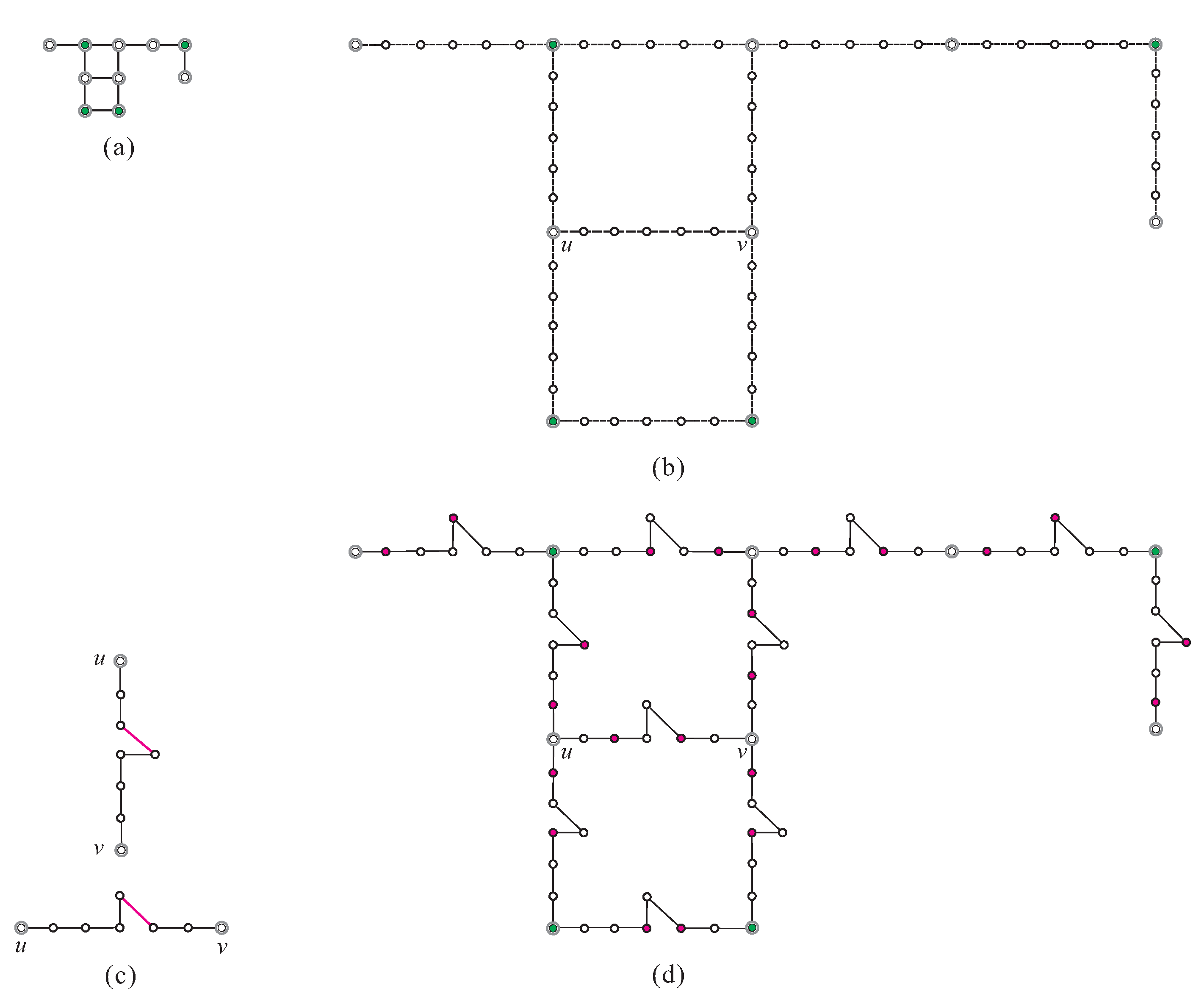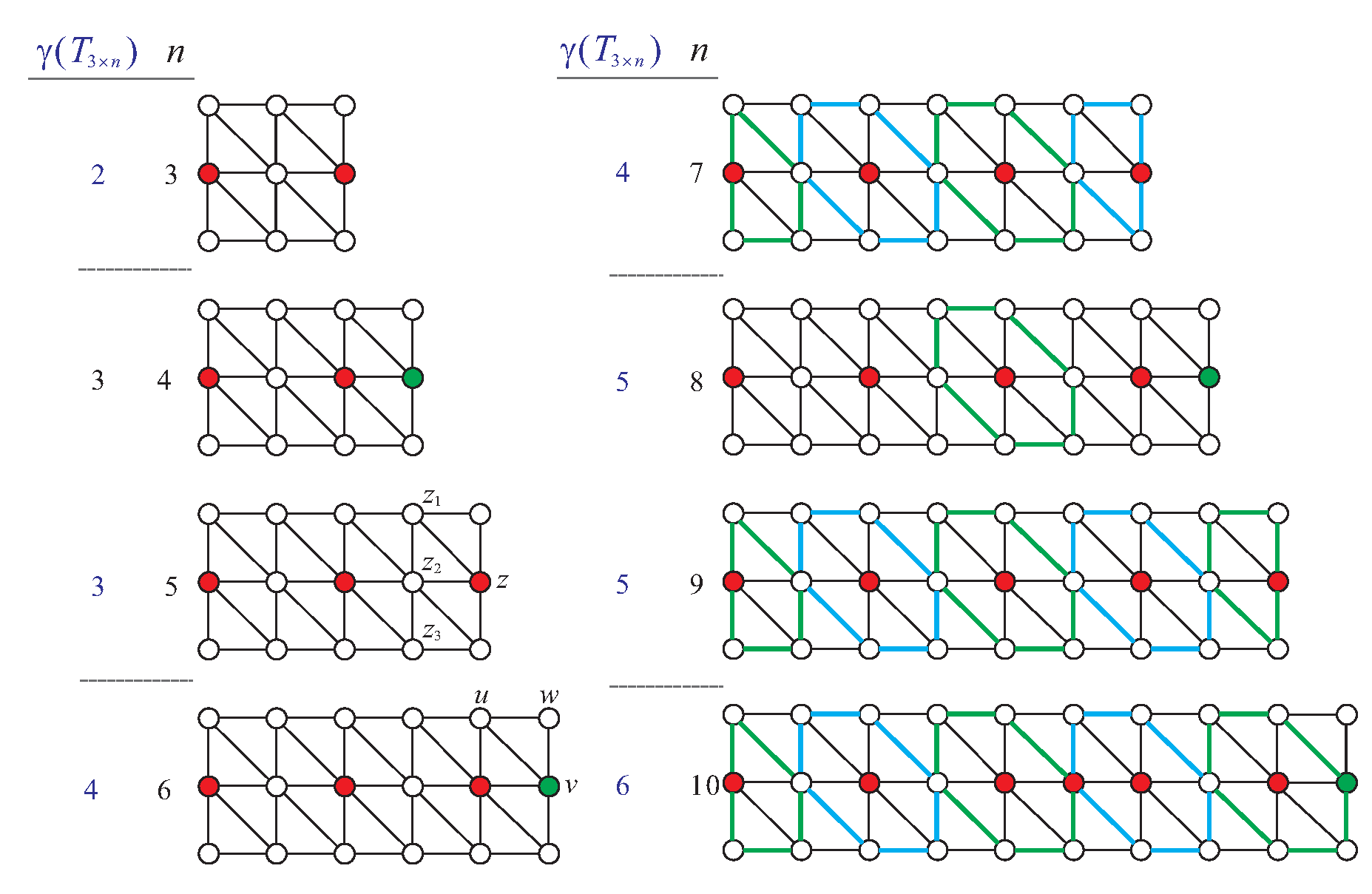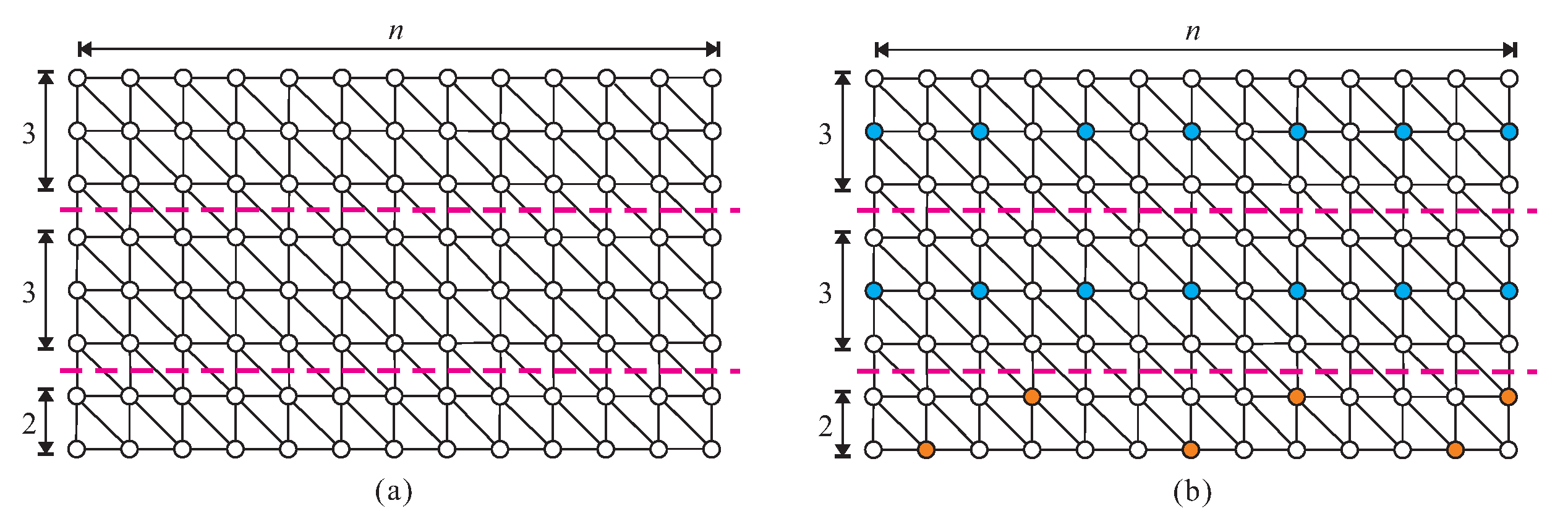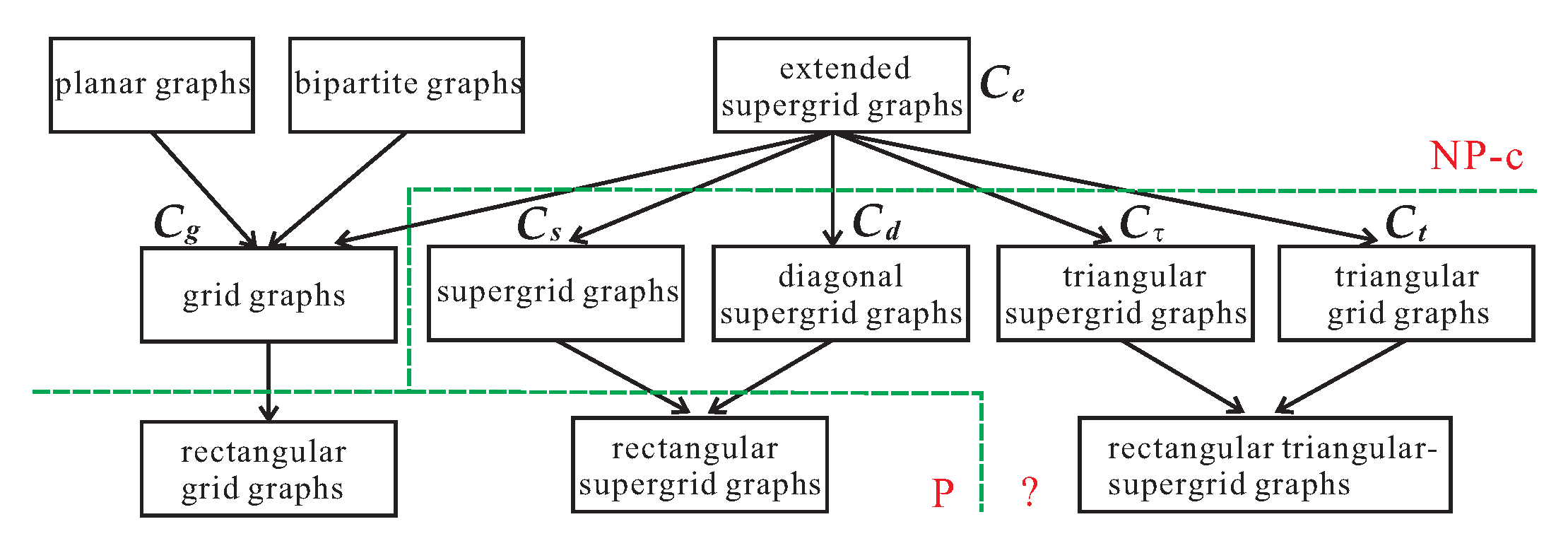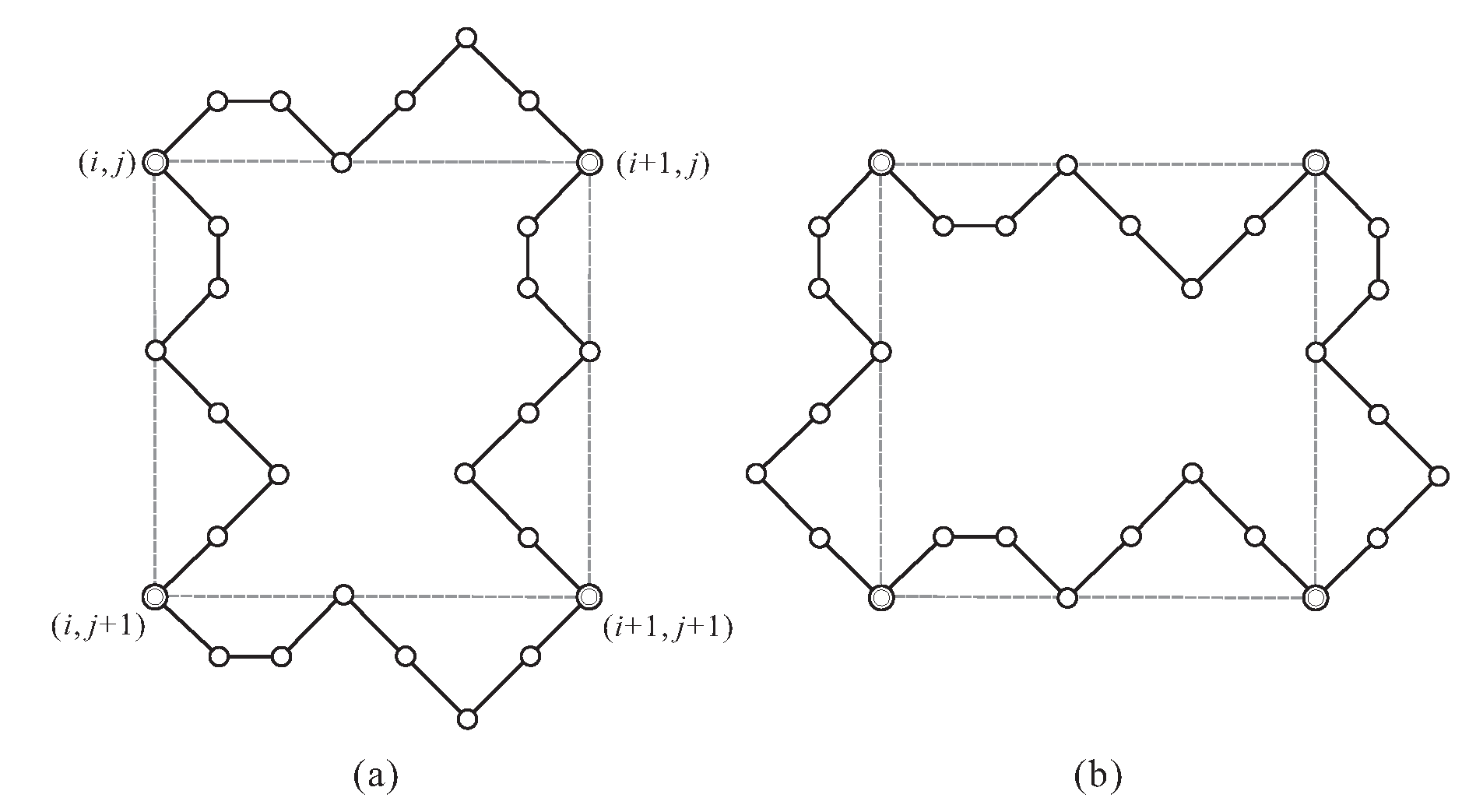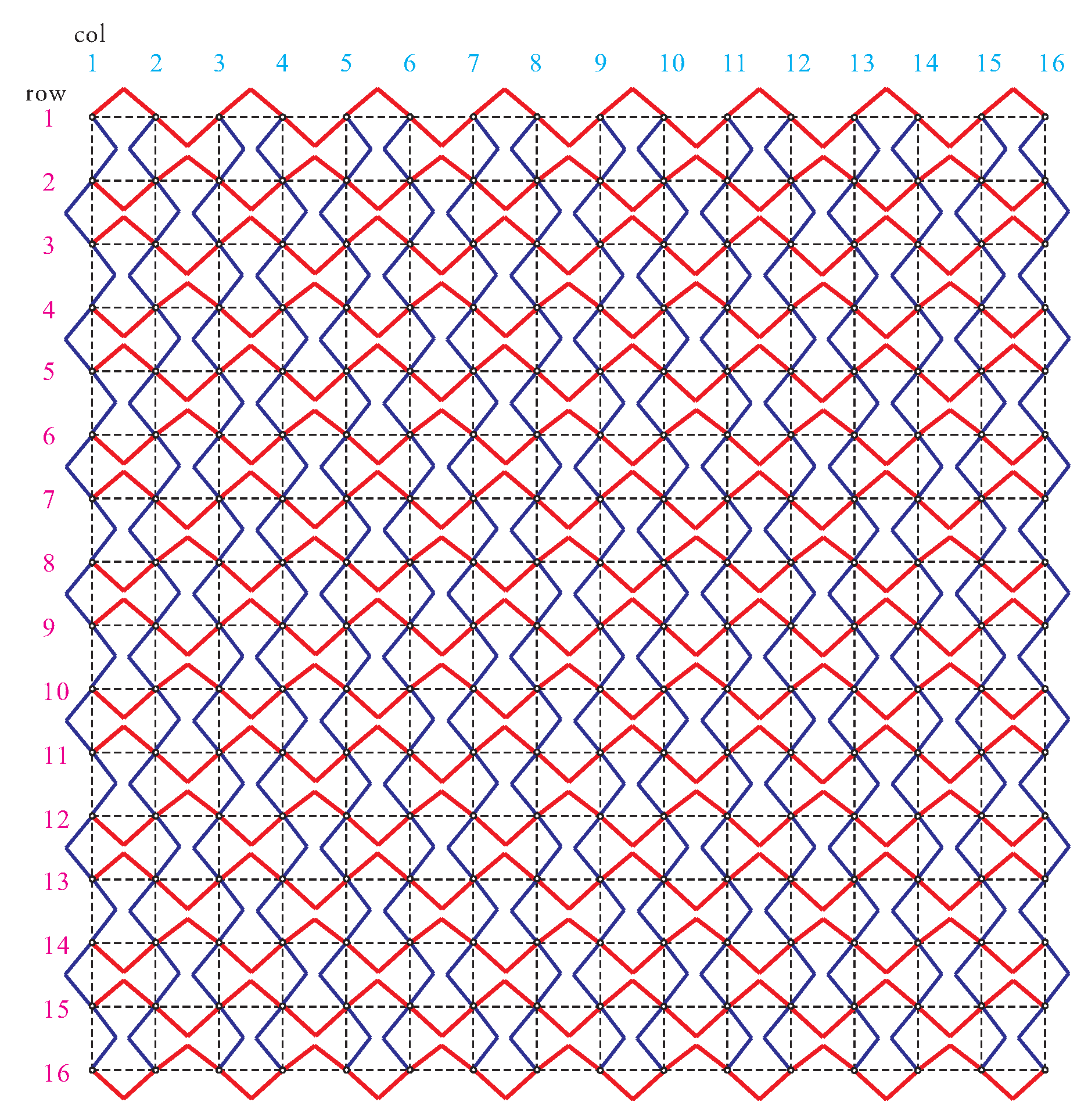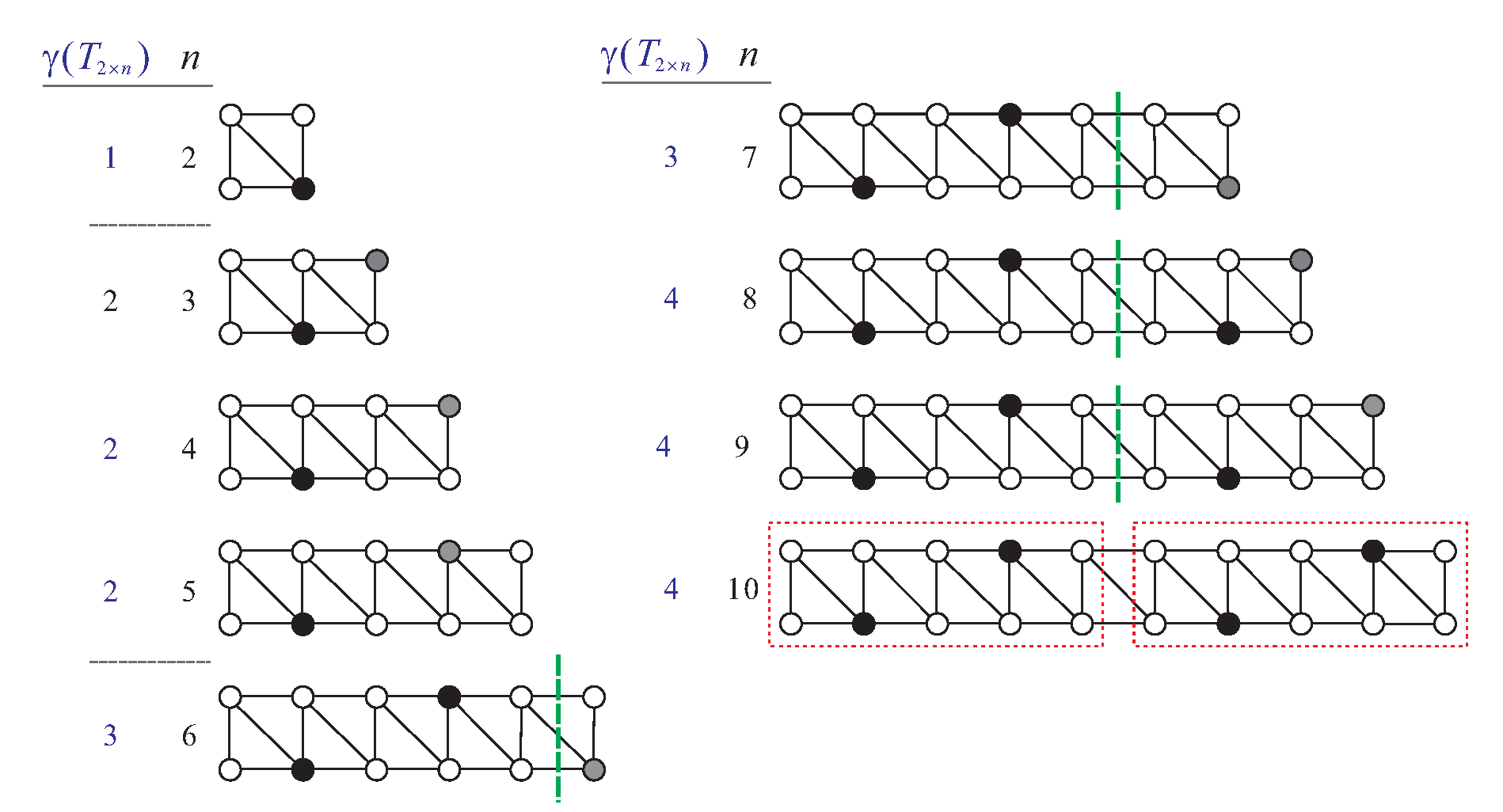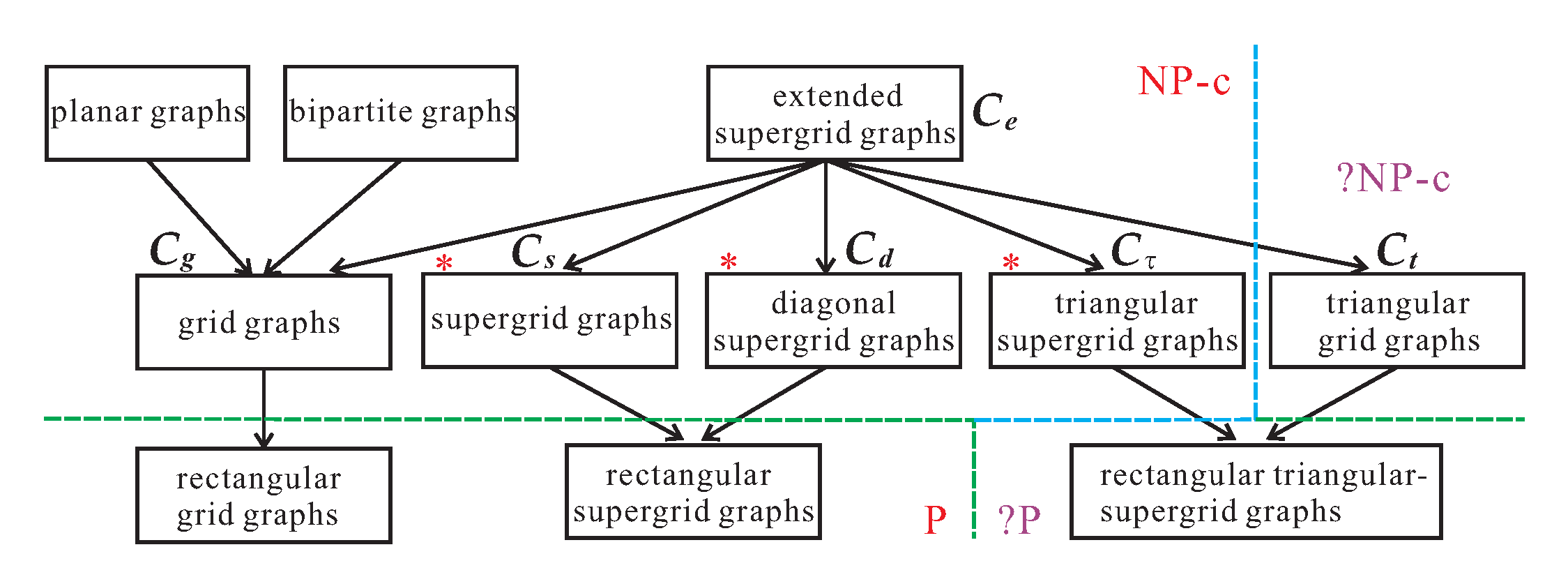1. Introduction
For a graph
G, we denote the vertex and edge sets of
G as
) and
, respectively. Let
v be a vertex of
, and let
S be a subset of
. We denote the subgraph induced by
S as
. The degree of vertex
v in
G is denoted by
, which represents the number of edges incident with
v in
G. The set of neighbors of a vertex
v in
G is denoted by
and
. The neighborhood set of vertex set
S in
G is defined as
and
. Let
; a set
D is said to dominate vertex
v if
. In addition, we can say that vertex
v dominates its neighbors and itself. We say that
D dominates
S when
D dominates every vertex of set
S. If
D dominates
, set
D is said to be a dominating set of
G. The domination number of a graph
G, expressed as
, is the minimum size of a dominating set of
G. A minimum dominating set of graph
G is a dominating set with size
. The
domination problem is to find a minimum dominating set of a graph, and is a well-known NP-complete problem for general graphs [
1]. However, the problem remains NP-complete when the input is restricted to certain special classes of graphs, including grid graphs [
2], 4-regular planar graphs [
1], etc.
In the literature, the problems of domination and its variants have been extensively studied. A variant of the domination problem is to find a minimum dominating set that satisfies some special conditions. For example, the connected domination problem is to compute a minimum dominating set such that the subgraph induced by it is connected, and the dominating cycle problem is to find a cycle with the least number of vertices to dominate the input graph. In the past, many scholars have proposed many applications for dominating sets and their variants. For instance, in distributed network applications the domination problem is to find the minimum number of control centers placed in the network to ensure that each node is close to at least one center. In a guard location system, the connected domination problem is to locate the fewest number of guards, allowing them to connect to each other in order to protect each other and monitor other locations. For related concepts and applications of these problems, we refer the reader to two survey books in [
3,
4]. In this paper, the domination problem, as well as one variant called the independent domination problem, are studied.
A set of vertices is called independent if any two vertices in it are not adjacent. An independent dominating set of a graph
G is a dominating set
I satisfying
I as an independent set. The independent domination number of a graph
G, expressed as
, is the minimum cardinality of an independent domination set in
G. Because an independent dominating set of a graph
G is a dominating set of
G,
for any graph
G. That is,
provides a trivial lower bound for
. The
independent domination problem on graph
G is to find an independent dominating set with size
. This problem is NP-complete for general graphs [
1], and remains NP-complete for grid graphs [
2], comparability graphs, bipartite graphs [
5], sat-graphs [
6], line graphs [
7], chordal bipartite graphs [
8], etc. However, when the input is in some special class of graphs, it allows polynomial-time algorithms, including permutation graphs, interval graphs [
9], chordal graphs [
10], circular-arc graphs [
11], AT-free graphs [
12], bounded clique-width graphs [
13], etc. For more relevant works on independent domination, we refer the reader to a survey in [
14], and more results in [
15,
16,
17,
18]. For other relevant works and comparisons, the reader is referred to [
19,
20,
21].
Supergrid graphs have been proposed for computing the stitch traces for computerized embroidery machines [
22]. Unfortunately, the Hamiltonian cycle and path problems on supergrid graphs have been shown to be NP-complete in [
22]. Thus, we studied the complexities of the Hamiltonian and longest paths for the special classes of supergrid graphs in [
23,
24,
25,
26,
27]. In this paper, we expand supergrid graphs to a generalized graph class called extended supergrid graphs. In general, a supergrid graph is not a grid graph, and vice versa. Extended graphs contain supergrid, grid, diagonal supergrid, triangular supergrid graphs as graph subcalsses. Generally, rectangular grid graphs form a subclass of grid graphs, rectangular supergrid graphs form a subclass of supergrid and diagonal supergrid graphs, and rectangular triangular-supergrid graphs are a subclass of triangular supergrid graphs. However, the intersection of rectangular grid graphs, rectangular supergrid graphs, and rectangular triangular-supergrid graphs is empty, except for certain special paths. In this paper, we study the complexities of domination and independent domination problems for extended supergrid graphs and their subclasses. The domination problem on grid graphs is known to be NP-complete [
2]. Thus, the studied problems are NP-complete as well for extended supergrid graphs. In [
28], we provided a rough proof to claim that the domination and independent domination problems on supergrid graphs are NP-complete. In this paper, we present a full proof to show that the domination and independent domination problems on diagonal supergrid graphs are NP-complete. By a simple extension, we verify that these two problems for supergrid and triagular supergrid graphs are NP-complete as well. On the other hand, the domination and independent domination numbers of rectangular grid graphs have been computed in [
18,
29,
30,
31]. In [
28], we solved the domination and independent domination problems on rectangular supergrid graphs in linear time. However, the complexities of the domination and independent domination problems on rectangular triangular-supergrid graphs remain unknown. In this paper, we provide a tight upper bound of the domination and independent domination numbers for rectangular triangular-supergrid graphs.
The remainder of this paper is organized as follows.
Section 2 describes the symbols used in this paper, definitions, and several known related results. In
Section 3, we first prove the domination and independent domination problems on diagonal supergrid graphs to be NP-complete in detail. We then extend this result into supergrid and triangular supergrid graphs. In
Section 4, we provide a tight upper bound of the domination and independent domination numbers for rectangular triangular-supergrid graphs. Finally, concluding remarks are made in
Section 5.
2. Preliminaries
In this section, we define the notation used in the paper and present results in the literature that are relevant to our work. For graph theory terms not defined here, the reader is referred to [
32]. Let
G be an undirected and simple graph with a vertex set
and an edge set
. A (simple) path
P in
G, expressed as
, is a sequence
of distinct vertices such that
for
. We use “
” to mean “
is a vertex that appears in
P” and the edge “
” to mean “
P visits edge
”. The path from vertex
to vertex
is represented as the
-path, and to avoid confusion we use
to denote a path with
n vertices. To simplify notation, we use % for modulo arithmetic throughout the rest of this paper. The following lemma shows the domination and independent domination numbers
and
of path
provided in [
30], and can be easily proven by induction on
n.
Lemma 1. (see [
30])
. , where n denotes the number of vertices in path . Due to the above lemma, the following proposed graph classes do not contain paths as graph subclasses. We introduce extended supergrid graphs and its subclasses of graphs as follows. Let
be an infinite graph such that its vertex set
contains all points of the Euclidean plane with integer coordinates and its edge set
and
, where
and
represent the
x and
y coordinates of vertex
, respectively, expressed as
for
. We call
the
two-dimensional integer supergrid. Suppose
. In the graph we represent, when
, this indicates that vertex
u is above
v, and when
,
u is to the left of
v. If
(respectively,
), then
is called a vertical (respectively, horizontal) edge; otherwise, it is called a diagonal edge. There are two types of diagonal edges
: if
and
, then diagonal edge
is called
l-skewed; otherwise, it is called
r-skewed. In our graph representation, when
is a
l-skewed diagonal edge and
u is above
v,
u is located at the upper right of
v in the plane; otherwise,
u is located in the upper left of
v in the plane. The
two-dimensional integer grid is an infinite graph that satisfies
and
is a horizontal or vertical edge}. In addition, the
two-dimensional triangular integer grid is an infinite graph satisfying
and
is a horizontal, vertical, or
r-skewed diagonal edge}. For example,
Figure 1a–c depicts partial fragments of the infinite graphs
,
and
, respectively.
An
extended supergrid graph is a finite
connected subgraph of
, while a
grid graph (respectively,
triangular grid graph,
supergrid graph) is a finite and
vertex-induced subgraph of
(respectively,
,
). Note that an extended supergrid graph is not necessarily a vertex-induced subgraph of
. Thus, extended supergrid graphs contain grid graphs, triangular grid graphs, and supergrid graphs as subclasses of graphs. A
diagonal supergrid graph is an extended supergrid graph with an edge set that contains at least one
l-skewed and one
r-skewed diagonal edge, and a
triangular supergrid graph is an extended supergrid graph such that its edge set contains at least one
r-skewed diagonal edge and no
l-skewed diagonal edges. In general, a diagonal supergrid graph is not necessarily a supergrid graph, and vice versa. The same applies to triangular supergrid graphs and triangular grid graphs. Let
,
,
,
,
, and
be the graph classes of extended supergrid, grid, supergrid, diagonal supergrid, triangular supergrid, and triangular grid graphs, respectively. Then,
,
,
, and
.
Figure 2 shows the relationship among these graph classes and indicates the complexities of the studied problems for these graph classes. Obviously, all grid graphs are bipartite [
33] and planar; however, (extended, diagonal, triangular) supergrid graphs and triangular grid graphs may not be bipartite. Let
,
, and
be a grid, supergrid, and triangular grid graph, respectively. Let
,
, and
. Then,
,
, and
. That is,
,
, and
.
A
rectangular grid graph, denoted
, is the Cartesian product of paths
and
; thus,
if and only if their distance is 1, that is,
, where
is the simple path with
i vertices. A
rectangular supergrid (called
King’s) graph, denoted
, is the strong product of paths
and
; thus,
if and only if their distance is less than or equal to
, that is,
and
. A rectangular triangular-supergrid graph, denoted
, is obtained from
by adding edges
for
,
, and
, i.e., adding diagonal
r-skewed edge to each square of
. Then, for
,
and
, we have
,
, and
. Furthermore, for
,
,
, and
. Note that we use
to denote the coordinates of the upper-left-most vertex of a (grid, supergrid, triangular supergrid) graph in the figures. For example,
Figure 3a–c shows
,
and
, respectively. Notice that
,
, and
are not paths; hence,
. Without loss of generality, we assume that
for these rectangular graphs.
A path in an extended supergrid graph is called a
horizontal (respectively,
vertical)
path if all of its edges are horizontal (respectively, vertical) edges. For instance, the arrow lines in
Figure 3b depict a horizontal path
. In [
28,
34], the domination number
and the independent domination number
of
are computed as follows:
Lemma 2. (see [
28,
34])
. . The complexities of the domination and independent domination problems on rectangular triangular-supergrid graphs remain open. In this paper, we provide a tight upper bound of and . To simplify notation, for a dominating set D of graph G and the subgraph H of G, we denote the restriction from D to H as . In our method, a partition may be made on a rectangular triangular-supergrid graph which is split into two disjoint parts, and is defined below.
Definition 1. Let T be a rectangular triangular-supergrid graph. The separation operation on T is to divide T into two vertex-disjoint rectangular triangular-supergrid subgraphs and , that is, and . If a separation consists of a set of horizontal edges, it is called vertical, and if it consists of a set of vertical edges, it is called horizontal. For example, the bold vertical (respectively, horizontal) dashed line in Figure 3c represents a vertical (respectively, horizontal) separation on divided into and (respectively, and ). 3. NP-Completeness Results
The domination and independent domination problems on grid graphs have been shown to be NP-complete [
2]; thus, they are NP-complete for extended supergrid graphs as well, as extended supergrid graphs contain grid graphs as a subclass of graphs (see
Figure 2). However, their complexities for diagonal supergrid, triangular supergrid, and supergrid graphs remain unknown. In [
28], we have provided a
rough proof to claim that they are NP-complete for supergrid graphs. In this section, we present a complete proof to show that they are NP-complete for diagonal supergrid graphs. We then expand this to verify that they are NP-complete for supergrid and triangular supergrid graphs as well. To demonstrate this, we establish a polynomial-time reduction from the domination problem on grid graphs. In [
2], Clark et al. provided the following theorem:
Theorem 1. (see [
2])
. The domination problem on grid graphs is NP-complete. We reduce the domination problem on grid graphs to the domination problem on diagonal supergrid graphs. Consider a grid graph
; a diagonal supergrid graph
is constructed to satisfy that
has a dominating set
D of size
if and only if
contains a dominating set
of size
. The steps for constructing the diagonal supergrid graph
from the grid graph
are as follows. First, the input grid graph
is enlarged to transform each edge of
into a vertical or horizontal path with seven edges, that is, each edge of
is enlarged by a factor of seven. The enlarged grid graph is represented as
. For example,
Figure 4b shows the grid graph
enlarged from
in
Figure 4a. The second step is to replace each
-path of the graph
with a special diagonal supergrid graph, where
. This special diagonal supergrid is a
-path with seven edges, and contains at least one
l-skewed and one
r-skewed edges; we call it
snake -path and denote it as
. For a snake
-path
,
u and
v are said to be the
connectors of
.
Figure 4c shows a snake
-path. Then, the constructed graph is a diagonal supergrid graph
. For example,
Figure 4d depicts a diagonal supergrid graph
constructed from the grid graph
in
Figure 4a.
Next, we propose a method for placing snake paths on the enlarged grid graph
such that any two snake paths are vertex-disjoint except for their connectors. Consider a square of a grid graph
with vertices
,
,
,
. Then, these four vertices are the connectors of the corresponding snake paths. If
are both odd or even, we place the four snake paths as shown in
Figure 5a; otherwise, we place these snake paths as shown in
Figure 5b. Then, in a corresponding square of an enlarged grid
, at most two snake paths are placed inside it and opposite each other. In addition, the two snake paths inside the corresponding square are separated by at least two integer points. Therefore, none of the vertices are repeated except for the connectors of the snake paths. Algorithm 1 illustrates the detailed steps above for placing snake paths. For example,
Figure 6 describes the arrangement of snake paths in
for
. Then, the following property holds immediately.
Lemma 3. Algorithm 1 arranges the snake paths of such that these paths are vertex-disjoint except for their connectors.
The construction algorithm of diagonal supergrid graph
is formally presented as Algorithm 1. Because a snake path is a diagonal supergrid graph and the input grid graph
contains at least one edge, the constructed graph
of Algorithm 1 is a diagonal supergrid graph. In addition, each edge of
is enlarged a constant number of times, and each enlarged edge is replaced with one snake path, Algorithm 1 runs in
-linear time. Thus, the following lemma holds true.
| Algorithm 1: The diagonal supergrid graph construction algorithm |
| | Input: A grid graph . (see Figure 4a) |
| | Output: A diagonal supergrid graph . (see Figure 4d) |
| | Method: // an algorithm for constructing a diagonal supergrid graph from a grid graph |
| 1. | enlarge to a grid graph , so that each edge of is transformed into a
vertical or horizontal path with 7 edges; (see Figure 4b) |
| 2. | let ; |
| 3. | foreach enlarged -path in , where do |
| 4. | | | let and be the vertices in grid graph with |
| | | | and |
| 5. | | | let be the snake -path corresponding to |
| | | | // Note that if , then is a horizontal path; otherwise, is a |
| | | | vertical path |
| 6. | | | ifthen |
| 7. | | | | | ifthen |
| 8. | | | | | | | ifthen |
| 9. | | | | | | | | | replace with in so that is above |
| 10. | | | | | | | else |
| 11. | | | | | | | | | replace with in so that is below |
| | | | | | | | | | |
| 12. | | | | | else |
| 13. | | | | | | | ifthen |
| 14. | | | | | | | | | replace with in so that is below |
| 15. | | | | | | | else |
| 16. | | | | | | | | | replace with in so that is above |
| | | | | | | | | | |
| | | | | | | | | | |
| 17. | | | else |
| 18. | | | | | ifthen |
| 19. | | | | | | | ifthen |
| 20. | | | | | | | | | replace with in so that is to the right of |
| | | | | | | | | | |
| 21. | | | | | | | else |
| 22. | | | | | | | | | replace with in so that is to the left of |
| | | | | | | | | | |
| 23. | | | | | else |
| 24. | | | | | | | ifthen |
| 25. | | | | | | | | | replace with in so that is to the left of |
| | | | | | | | | | |
| 26. | | | | | | | else |
| 27. | | | | | | | | | replace with in so that is to the right of |
| | | | | | | | | | |
| | | | | | | | |
| | | | | | |
| | | | |
| 28. | output.
|
Lemma 4. Given a grid graph , Algorithm 1 constructs a diagonal supergrid graph in -linear time.
Next, we verify that grid graph has a dominating set D of size if and only if diagonal supergrid graph contains a dominating set of size . Before providing the proof, we first observe several properties of the snake path. Note that the snake path is a simple path with eight vertices. Recall that for a dominating set D of graph G and the subgraph H of G, we denote the restriction from D to H as . Let be a dominating set of diagonal supergrid graph , and let be a snake path with connectors u and v in . Let if , and if . Then, and dominate u and v, respectively, if . According to whether u and v are in , we consider the following situations.
Case 1:
. Because
is a dominating set of
,
is a path
with four vertices. Per Lemma 1,
(see
Figure 7a). Therefore,
and
.
Case 2: either
or
. Without loss of generality, assume
and
. Consider that
does not contain
. Then,
is a path
with five vertices. Per Lemma 1,
On the other hand, Consider that
contains
. Then,
is a path
with six vertices. Per Lemma 1,
(see
Figure 7b). In any case,
,
, and if
does not dominate
v then there exists a vertex
in
such that
dominates
v.
Case 3: . Depending on the positions of and , we have the following three subcases.
Case 3.1:
. In this subcase,
. Then,
is a path
with six vertices. Per Lemma 1,
(see
Figure 7c). Thus,
.
Case 3.2: either
or
. Without loss of generality, assume that
and
. Then,
is a path
with four vertices. Per Lemma 1,
(see
Figure 7d). Thus,
and
. Then,
.
Case 3.3: . In this subcase, it needs at least one other vertex of to dominate . Thus, and .
It follows from the above cases that we can conclude the following lemma.
Lemma 5. Let be a dominating set of diagonal supergrid graph constructed by Algorithm 1, and let be a snake path with connectors u and v in . Then, the following statement holds:
- (1)
If , then and (see Figure 7a). - (2)
If and , then , , and if does not dominate v, then there exists a vertex in such that dominates v (see Figure 7b). - (3)
If , then
if and , then and (see Figure 7c); otherwise, and (see Figure 7d).
Figure 7.
The minimum dominating set of in for (a) , (b) and , (c) and and , and (d) and, or , where is a dominating set of and filled circles represent vertices in .
Figure 7.
The minimum dominating set of in for (a) , (b) and , (c) and and , and (d) and, or , where is a dominating set of and filled circles represent vertices in .
Based on the above lemma, we prove that grid graph contains a dominating set D with if and only if diagonal supergrid graph has a dominating set with . We first prove that the only if part is as follows.
Lemma 6. Suppose grid graph has a dominating set D with size . Then, diagonal supergrid graph contains a dominating set with size .
Proof. We construct a dominating set
of
from
D such that the size of
is no greater than
. Initially, let
. Let
be an edge of the grid graph
, and let
be the snake
-path in the diagonal supergrid graph
constructed from
, as depicted in
Figure 7a. Consider the following three cases.
Case 1:
. In this case,
and
are dominated by
u and
v, respectively. Let
. Per Lemma 1,
. Then,
is a minimum dominating set of
. Let
. Then,
dominates
and
.
Figure 7a shows such a dominating set of
.
Case 2: either
or
. Without loss of generality, assume that
and
. Then,
is dominated by
u. Consider that
v is not dominated by
. Let
. Per Lemma 1,
. Then,
is a minimum dominating set of
. Let
. Then,
dominates
and
.
Figure 7b depicts such a dominating set of
. On the other hand, consider that
v is dominated by
. Let
. Per Lemma 1,
. Then,
is a minimum dominating set of
. Let
. Then,
dominates
and
.
Case 3:
. Because
D is a dominating set of
, there exist two vertices
and
such that
and
dominate
u and
v, respectively. Let
and
be the snake paths of
constructed from edges
and
, respectively. In our construction algorithm of
, we compute the dominating sets of
and
before the dominating set of
, where
and
. From Case 2, we can find one vertex of
(respectively,
) to dominate
u (respectively,
v) before computing the dominating set of
(see
Figure 7b). By Lemma 1, there exists a set
of
such that it dominates
; see
Figure 7c. Let
. Then,
dominates
and
.
Based on the above cases, we construct a dominating set
of
by the following steps. Initially, let
and let
. For each
, we construct a dominating set of
via Case 1. We then construct a dominating set of
by Case 2 for each
and
. Finally, for each
, a dominating set of
is constructed via Case 3. From the above cases,
after processing each snake path of
. Thus, we construct a dominating set
of
with size
after computing dominating sets of all snake paths in
. For example,
Figure 4a shows the dominating set
D of
with
, and the constructed dominating set
of
from
D is shown in
Figure 4d, where
. This completes the proof of the lemma. □
Next, we prove that the if part is in Lemma 7. Recall that for a dominating set D of graph G and the subgraph H of G, the restriction of D to H is represented as .
Lemma 7. Suppose diagonal supergrid graph has a dominating set with . Then, grid graph contains a dominating set D with size .
Proof. We show that there exists a dominating set D of with size k or less. To prove this lemma, we first construct a dominating set of obtained from such that and remove all vertices not in from , resulting in a dominating set D of . Initially, let . Consider a snake path of constructed from edge of . Let (respectively, ) be in such that it dominates u (respectively, v) if (respectively, ). Depending on whether , we have the following three cases:
Case 1: . Let . By Lemma 1, . Let be a minimum dominating set of . If , then let , that is, , after processing for .
Case 2: either
or
. Without loss of generality, assume that
and
. Then,
is dominated by
u. Let
. By Statement (2) of Lemma 5, at least two vertices of
are in
. Let
be a minimum dominating set of
; see
Figure 7b. If
or
, then let
, that is,
in this case. In addition,
dominates
v after processing
for
and
.
Case 3:
. First, consider that
and
. Then,
and
only contains a snake path
. By Lemma 1,
. Let
. Then,
is a dominating set of
with size 3. Let
; hence,
D is a dominating set of
with size 1. Then,
, and hence
. Thus, the lemma holds when
and
. In the following, suppose that
or
. Then, there exists at least one vertex
of
such that
or
. Without loss of generality, assume that
. We pick
to satisfy the requirement that if
, then
. Let
be the snake path of
constructed from edge
of
, as shown in
Figure 8a. Depending on whether
, there are two subcases.
Case 3.1:
. In this subcase,
. Suppose that
. By Statement (3) of Lemma 5,
. Let
. Then, the size of
does not increase and
. On the other hand, suppose that
. By Statement (3) of Lemma 5,
. Let
. Then, the size of
does not increase and
. In any case, we can set
and
does not increase. Then, it is the same as Case 2.
Figure 8a depicts such a case.
Case 3.2:
. In this subcase,
and
is a minimum dominating set of
; see
Figure 8b,c. If
or
, let
. Depending on whether
, we consider the following subcases.
Case 3.2.1:
. In this subcase, there exists a vertex
of
. We pick such a vertex
, which is the same as that of
. Let
be the snake path of
constructed from edge
of
, as shown in
Figure 8b. If
, then it is the same as Case 3.1. Consider that
. Then,
is a minimum dominating set of
and
v is dominated by
. If
or
, then let
. In addition,
u and
v are dominated by
after processing
and
. By Statement (3) of Lemma 5,
. Let
be a minimum dominating set of
. If
, then let
.
Figure 8b depicts a such construction of
.
Case 3.2.2:
. In this subcase,
dominates
v; see
Figure 8c. By Statement (3) of Lemma 5,
. We then set
u to be in
and re-compute the minimum dominating set of
, that is,
. Then,
does not increase and
.
Figure 8c shows a such minimum dominating set of
in this subcase.
Figure 8.
The dominating set of snake path in where , where (a) , (b) and , and (c) and . Note that is a dominating set of ; the filled circles represent vertices of .
Figure 8.
The dominating set of snake path in where , where (a) , (b) and , and (c) and . Note that is a dominating set of ; the filled circles represent vertices of .
From the above cases, we can construct a dominating set
of
from
such that
, as follows. First, for each
we construct dominating sets of
via Case 3. Then, for each
and
we construct dominating sets of
via Case 2. Finally, we construct dominating sets of
via Case 1 for
. For example, given a dominating set
of
with size 22 in
Figure 9a, the constructed dominating set
of
with size 22 from
is depicted in
Figure 9b. Then,
satisfies the following properties:
- (p1)
,
- (p2)
for each snake -path , , and
- (p3)
for each snake -path with , there exist and such that while and .
Figure 9.
(a) The dominating set of with size 22, and (b) a dominating set of with size 22 () obtained from . Solid lines indicate the edges of , double circles represent the vertices of , and filled circles indicate the vertices in a dominating set of .
Figure 9.
(a) The dominating set of with size 22, and (b) a dominating set of with size 22 () obtained from . Solid lines indicate the edges of , double circles represent the vertices of , and filled circles indicate the vertices in a dominating set of .
Then, a dominating set D of is obtained from according to the following steps:
- (s1)
initially, let ;
- (s2)
remove from D all vertices of D that are not in ;
- (s3)
the result set D is a dominating set of .
Because for each snake path , contains exactly two vertices that are not in , we obtain . Then, . Therefore, we construct a dominating set D of of size . □
It immediately follows from Lemmas 6 and 7 that the following lemma is summarized:
Lemma 8. Let be a grid graph, and let be a diagonal supergrid graph constructed from by Algorithm 1. Then, has a dominating set D with size if and only if contains a dominating set with size .
Obviously, the domination problem on a diagonal supergrid graph is in NP. By Theorem 1 and Lemmas 4 and 8 we derive the following theorem:
Theorem 2. The domination problem for diagonal supergrid graphs is NP-complete.
The dominating sets of diagonal supergrid graphs constructed in Lemmas 6 and 7 can be easily modified to be independent dominating sets. Therefore, the independent domination problem on diagonal supergrid graphs is NP-complete as well, and the following corollary holds true.
Corollary 1. The independent domination problem for diagonal supergrid graphs is NP-complete.
Through the construction of diagonal supergrid graph , we can see that is a supergrid graph which is a vertex-induced subgraph of the infinite two-dimensional supergrid . Therefore, the following theorem holds immediately.
Theorem 3. The domination and independent domination problems for supergrid graphs are NP-complete.
The NP-complete results above can be easily extended to triangular supergrid graphs. Recall that a triangular supergrid graph is an extended supergrid graph of which the edge set contains at least one r-skewed diagonal edge and does not contain any l-skewed diagonal edges. To verify that the domination problem on a triangular supergrid graph is NP-complete, we modify Algorithm 1 as follows:
- Step 1:
enlarge the input grid graph
to another grid graph
such that each edge of
is transformed into a horizontal or vertical path with six edges (see
Figure 10b);
- Step 2:
for each horizontal (respectively, vertical)
-path in
where
, replace it by a horizontal (respectively, vertical) triangle path
connecting
u and
v (see
Figure 10c);
- Step 3:
the constructed graph is a triangular supergrid graph
(see
Figure 10d), and outputs
.
Figure 10.
(a) A grid graph , (b) grid graph by magnifying each edge of by a factor of six, (c) (horizontal or vertical) triangle -path , and (d) a triangular supergrid graph constructed from by replacing each of its enlarged paths with the triangle path in (c).
Figure 10.
(a) A grid graph , (b) grid graph by magnifying each edge of by a factor of six, (c) (horizontal or vertical) triangle -path , and (d) a triangular supergrid graph constructed from by replacing each of its enlarged paths with the triangle path in (c).
We can see that each triangle path is a path with eight vertices. Thus, Lemma 5 holds for . By Lemma 8, has a dominating set D of size if and only if contains a dominating set of size . Therefore, the following theorem holds immediately.
Theorem 4. The domination and independent domination problems on triangular supergrid graphs are NP-complete.
4. The Domination and Independent Domination Numbers of Rectangular Triangular-Supergrid Graphs
In this section, we first compute for a rectangular triangular-supergrid graph with and . We then provide an upper bound of and for . First, we consider and , as follows.
Lemma 9. .
Proof. Through the structure of
, a vertex of
dominates at most five vertices, including its four neighbors and itself. Thus,
. We compute a dominating set of
with size
, as follows. First, we make
or
vertical separations on
to obtain
subgraphs
,
,
…,
,
of
such that
,
is a rectangular triangular-supergrid graph
and
is a
,
, if
. Note that
when
. Let
and
be two vertices of
for
, and let
. Then,
is a dominating set of
. Consider that
does exist, i.e.,
. Then,
for
. We then compute one or two vertices
and
of
as follows: if
, let
; otherwise, if
, let
. Furthermore, if
, let
and
; otherwise, if
, let
and
. Then,
dominates
. Let
. Then,
and
D dominates
. Thus,
. By the above construction, we can see that
D is an independent dominating set of
; hence,
. For instance,
Figure 11 depicts our constructed (independent) dominating set of
for
. □
Next, we compute and as the following lemma.
Lemma 10. .
Proof. We first claim the following:
- (C1)
There exists a minimum dominating set of with size such that if ; otherwise, .
- (C2)
For any minimum dominating set of , does not contain vertex , and if , then contains vertex and does not contain vertex .
We prove the above claims by induction on
n, where
. Initially, let
, 4, or 5. By inspecting
,
, and
, it is easy to verify that the above claims hold true; see
Figure 12. Assume that the claims hold when
and
. Then, there exists no minimum dominating set of
containing vertex
, and there exists a minimum dominating set
of
with size
such that
if
; otherwise,
. In addition, if
, then any minimum dominating set
of
satisfies the requirement that
contains vertex
and does not contain vertices
and
. Now, suppose that
. There are two possible cases.
Case 1: . Let , . By induction hypothesis, any minimum dominating set of does not contain vertex ; hence, does not dominate vertex . Thus, . Let . Then, ; hence, is a minimum dominating set of . Therefore, Claim (C1) holds true in this case. Next, we verify Claim (C2). Let , , and let . Assume by contradiction that is a minimum domination set of satisfying the requirement that contain vertex . To dominate w, one of must be in . Consider that . Then, by induction hypothesis. Then, ; hence, . Thus, . This contradicts our above construction of with size . In addition, consider that w or v is in . Then, ; hence, . By induction hypothesis, . Then, . Thus, , where and is a dominating set of ; hence, a contradiction occurs. By contradiction, there exists no minimum domination set of containing vertex . Thus, Claim (C2) holds true when .
Case 2:
. In this case, let
. Then,
. Because
is a subgraph of
,
, it is true that
is a minimum dominating set of
. Thus, Claim (C1) holds true in this case. Next, we verify Claim (C2) in this case. By similar arguments to those proving Case 1, we can verify that there exists no minimum domination set of
containing vertices
and
. Let
,
,
,
, and let
, as shown in
Figure 12. Assume by contradiction that there exists a minimum domination set
of
such that
. To dominate
and
, at least two vertices of
Z are necessary. If
, then
is not a minimum dominating set of
; by induction hypothesis, a contradiction occurs. Thus,
. Let
. Then,
remains a dominating set of
, as
; that is,
is not a minimum dominating set of
. Thus,
. This contradicts the requirement that
constructed above be a dominating set of
with size
. Thus, any minimum domination set of
contains vertex
. It follows from the above arguments that Claim (C2) holds true when
.
By the above cases, Claims (C1) and (C2) hold true when
. By induction, these claims hold true for
. Thus,
.
Figure 12 shows the minimum dominating set
of
for
.
Because each independent dominating set of a graph is a dominating set for that graph, . For the case of , in Claim (C1) is an independent set as well; hence, it is a minimum independent dominating set of . Consider . Let . Then, and is an independent set. Thus, is a minimum independent dominating set of . In any case, we construct a minimum independent dominating set of with size . Thus, . □
Figure 12.
for ; filled circles indicate the vertices in the minimum (independent) dominating set of .
Figure 12.
for ; filled circles indicate the vertices in the minimum (independent) dominating set of .
Next, we consider for a rectangular triangular-supergrid graph .
Lemma 11. Let be a rectangular triangular-supergrid graph with . Then, and .
Proof. Based on Lemmas 1, 9 and 10, we compute an (independent) dominating set of
as follows. First, we make
or
horizontal separations on
to obtain
disjoint subgraphs
and one
if
, as shown in
Figure 13a. Let
,
, ⋯,
be partitioned subgraphs such that
is located above
for
. By Lemma 10, we can obtain a minimum (independent) dominating set
of
with size
for
. Depending on the number of
, we consider the following cases:
Case 1: . In this case, let be the minimum (independent) dominating set of constructed from the proof of Lemma 10, and let . Then, .
Case 2: . In this case, let be the minimum (independent) dominating set of constructed from Lemma 1. Then, . Let . Then, .
Case 3: . In this case, let be the minimum (independent) dominating set of constructed from the proof of Lemma 9. Then, . Let . Then, .
In any case, we construct a (independent) dominating set
D of
with size
or less. For example,
Figure 13b shows the constructed (independent) dominating set
D of
with size
. That is, we obtain an upper bound
of
(
), and hence the lemma holds true. □
Figure 13.
(a) Partitioning of into disjoint subgraphs, and (b) an (independent) dominating set of . Solid dashed lines indicate separations and filled circles indicate vertices in the (independent) dominating set.
Figure 13.
(a) Partitioning of into disjoint subgraphs, and (b) an (independent) dominating set of . Solid dashed lines indicate separations and filled circles indicate vertices in the (independent) dominating set.
By the above lemma, we can see that each vertex in the constructed (independent) dominating set of almost dominates six vertices. By the structure of , each vertex dominates at most seven vertices, including its six neighbors and itself. However, there exists no dominating set of in which its each vertex dominates seven vertices. Thus, . Because an independent dominating set of a graph is a dominating set of the graph, provides a trivial lower bound of . Then, for . Thus, we obtain a tight upper bound of and . Using Lemmas 9–11, we can conclude the following theorem.
Theorem 5. Let be a rectangular triangular-supergrid graph with . Then, if , and Proof. By Lemma 9, . By Lemma 10, . Lemma 11 provides that and for . In addition, if . Thus, the theorem holds true. □



